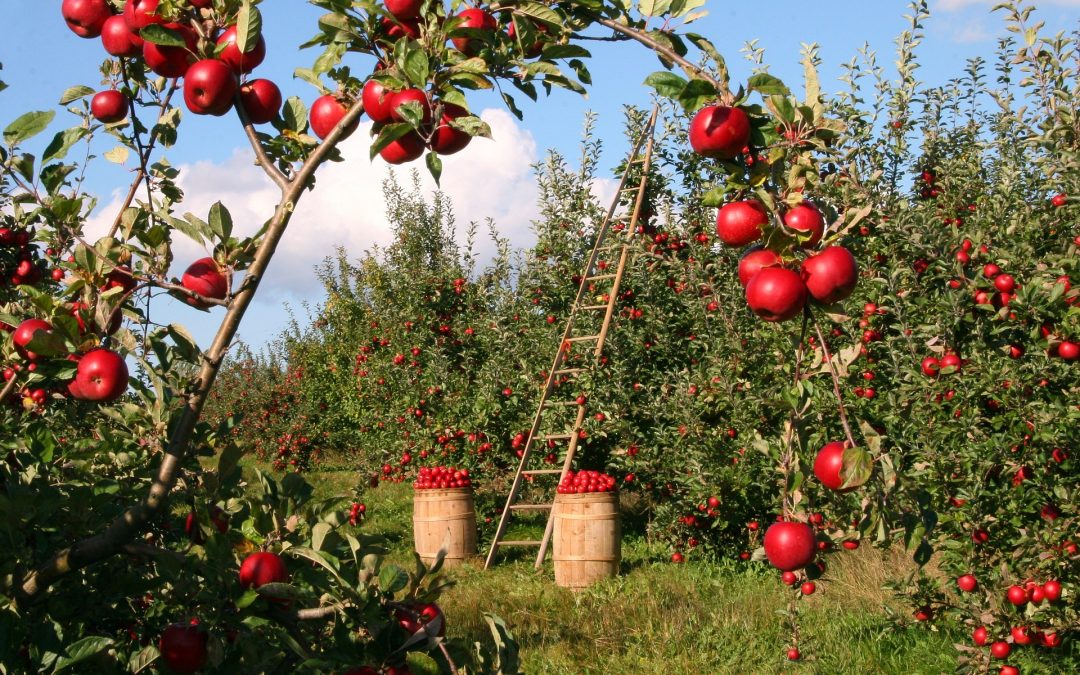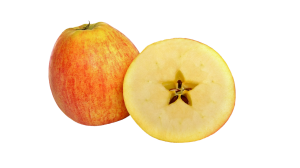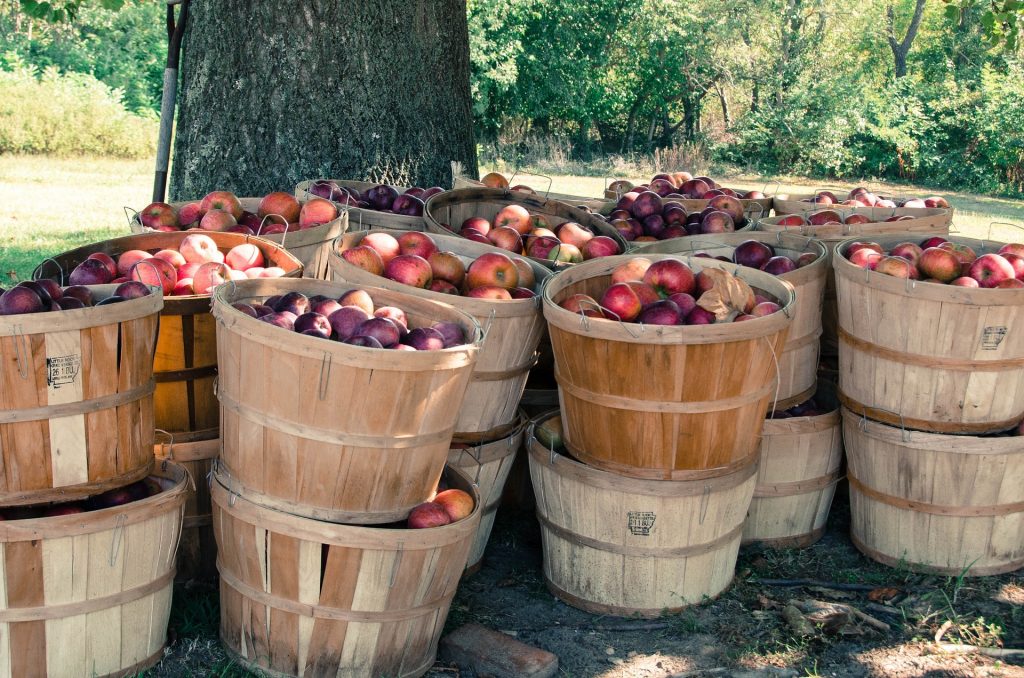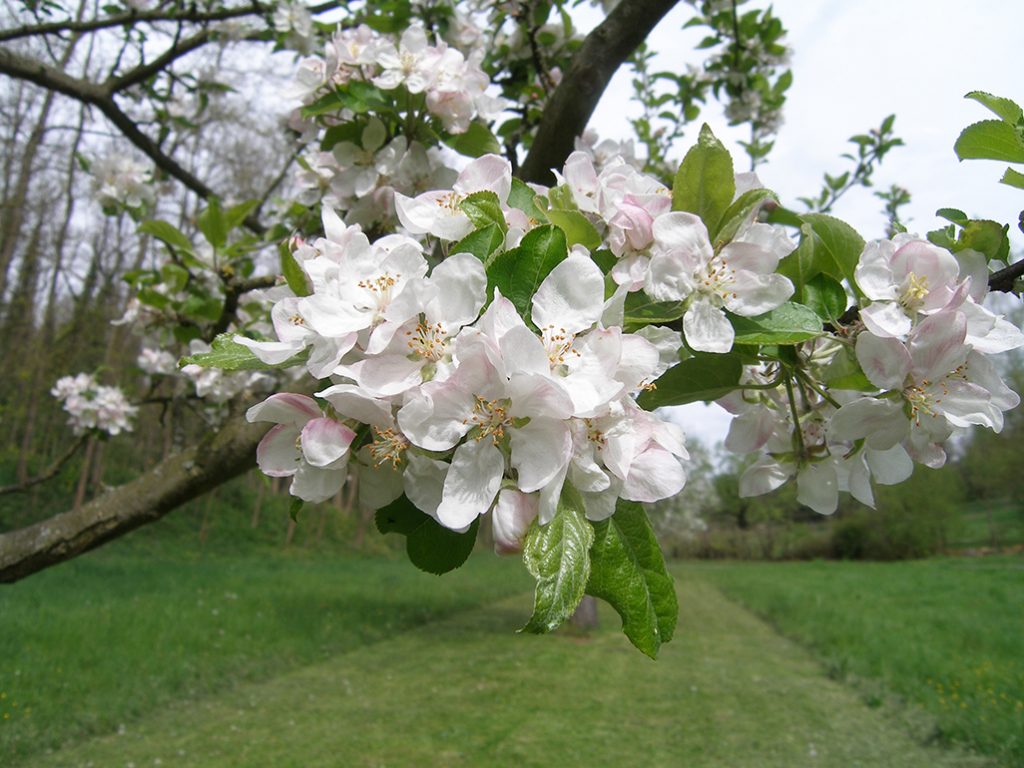
Apple Tree
Description:
The Apple Tree is one of the most anciently cultivated fruits of Eurasia. It is believed to have developed in central Asia, where the greatest genetic variation occurs in the wild. In cultivation, trees are usually trained and do not reach more than approx 5m in height to facilitate easy harvesting. When grown under natural conditions they can reach up to 12m.
The tree belongs to the Rose family. It has typical, highly conspicuous 5-petaled flowers growing in cymes and simple, ovate, alternate leaves, dark green on top and lightly downy underneath. The leaf margins are serrate.
A mature apple tree looks like a grandmother tree: small in stature, writhing limbs and with grey, crinkly bark. It does not exactly impress with its habitus, yet we learn to love it from an early age. Children not only love its wonderful fruits but also the inviting limbs that make it ideal for climbing and just about every child will sooner or later become intimately acquainted with it. In spring it is particularly noticeable and fetching. Before any leaves are beginning to show it is clad in a glorious dress of pinkish-white flowers and buzzing with delirious bees. Once the flowers have faded we pass it by without paying much attention, but come September, when it is laden with shining, red or golden apples, it is impossible to resist. Even crab apples, whose fruit are much smaller (and tarter), look tempting.
It is estimated that there may be as many as 20000 cultivated varieties, each with their own distinct flavour, shape, smell, crunchiness, and succulence, though nobody knows the exact number. Sadly, most of them are endangered heirloom species, confined to just a few gardens. The average supermarket only carries about 5 standard varieties.
Ecology:
Apple trees are an important source of food: they provide nectar for bees, and their apples are a welcome source of nutrition for many species of wildlife.
Distribution:
Apple trees are so widespread that it is almost impossible to pin down their origin. Charred remains of prehistoric crab apples found at archaeological sites throughout Europe are a testimony to the fact that wild apples had spread throughout much of Eurasia by Neolithic times. The first cultivated varieties probably reached northern parts of Europe with the Romans. Today apples are grown in all temperate regions of the globe.
History & Mythology
 The apple tree is perhaps the most mythical of all trees – is it not supposed to have been the demise of all mankind, way back at the beginning of time? Well, so the story goes, but it is actually highly unlikely that the forbidden fruit, which gave us knowledge of good and evil, would have been an apple since apples were unknown in Egypt and Palestine at the time when the earliest biblical accounts were written down. In these accounts, the story merely refers to ‘a fruit’. However, long before Christianity was ever conceived of, the apple tree was already a widely adored symbol of immortality. Its fruit was regarded as the sacred heart of the Goddess of Eternal Life. In Celtic tradition the paradise on the western horizon, where the souls of the Blessed go, was known as Avalon, the Isle of Apples, which was guarded by Morgan, Queen of the Dead.
The apple tree is perhaps the most mythical of all trees – is it not supposed to have been the demise of all mankind, way back at the beginning of time? Well, so the story goes, but it is actually highly unlikely that the forbidden fruit, which gave us knowledge of good and evil, would have been an apple since apples were unknown in Egypt and Palestine at the time when the earliest biblical accounts were written down. In these accounts, the story merely refers to ‘a fruit’. However, long before Christianity was ever conceived of, the apple tree was already a widely adored symbol of immortality. Its fruit was regarded as the sacred heart of the Goddess of Eternal Life. In Celtic tradition the paradise on the western horizon, where the souls of the Blessed go, was known as Avalon, the Isle of Apples, which was guarded by Morgan, Queen of the Dead.
While the Neolithic Lake-villagers of north-central Switzerland are known to have feasted on Crab apples, cultivated varieties reached central and northern Europe with the Romans. They too, associated eternity with the apple. Alpha and omega, the beginning and the end, the two poles that encompass existence, were represented by an egg, symbolic of the source of life (alpha), and an apple, the symbol of the immortality of the soul and its resurrection (omega). Thus, each of their feasts would start with an egg and finish with an apple. Wild boars (pigs and boars are sacred totems of the Great Goddess,) were roasted with an apple in their snout to represent eternal life and rebirth.
 The apple is a fruit of Venus/Aphrodite and it bears her signature, the five-pointed star. Among gypsies, it is traditional to cut the apple horizontally to reveal this mystical insignia of the Goddess. Greek mythology involves the apple in a more tragic and fateful story, the story of Paris, who was assigned the impossible task to settle a dispute between three Goddesses and decide who was the fairest of them all. How was he ever to make such a choice? The youth was doomed and he knew it. But decide he must, there was no way around it. The chosen one was to receive a golden apple, inscribed with the words ‘to the most deserving’. In the end, it was Aphrodite who won him over by bribing him. She promised him the love of Helen, the most beautiful mortal woman alive on earth at the time. Alas. his choice turned out to be short-sighted and not very wise, as that beautiful young woman was already married to another. Nevertheless, Paris ran away with her, which inadvertently started the chain of events that eventually lead to the Trojan War.
The apple is a fruit of Venus/Aphrodite and it bears her signature, the five-pointed star. Among gypsies, it is traditional to cut the apple horizontally to reveal this mystical insignia of the Goddess. Greek mythology involves the apple in a more tragic and fateful story, the story of Paris, who was assigned the impossible task to settle a dispute between three Goddesses and decide who was the fairest of them all. How was he ever to make such a choice? The youth was doomed and he knew it. But decide he must, there was no way around it. The chosen one was to receive a golden apple, inscribed with the words ‘to the most deserving’. In the end, it was Aphrodite who won him over by bribing him. She promised him the love of Helen, the most beautiful mortal woman alive on earth at the time. Alas. his choice turned out to be short-sighted and not very wise, as that beautiful young woman was already married to another. Nevertheless, Paris ran away with her, which inadvertently started the chain of events that eventually lead to the Trojan War.
In China, by contrast, the pictogram for ‘apple’ also means ‘peace’. Thus to present someone with an apple is a gesture of goodwill and peace.
In western tradition, apples became associated with erotic love and sin – thanks to the misinterpretation of the church fathers. For centuries it was thus used metaphorically in ecclesiastic art. However, as Christianity became ever more fanatical, focusing on the evils of the flesh and condemning women as witches, the apple came to symbolize temptation and evil; a symbol of sinful, carnal love and even the devil himself. Which is how they became known as ‘malus’, (=bad), and the tree was reinterpreted as a ‘witches’ tree.’
Apple trees are also the most common host species of Mistletoe, one of the most sacred plants of the Druids. However, they favoured Oak as a host-plant for Mistletoe, which is far rarer.
Once upon a time, when Halloween was more than a spooky fun day for kids, it marked the pagan New Year, a time when the life-force retreats into the womb of the earth, where it would regenerate and restore its powers, ready to be reborn the following spring. Apples are the sacred fruit of the season symbolic of eternal life and resurrection. Apple bopping games and other customs are remnants of such ancient pagan traditions, which allude to the eternal life of the soul.

During the time of the apple harvest farmers traditionally engaged in the custom of ‘wassailing’, a kind of tree blessing that was meant to invoke their innate fertility, chase off evil spirits that might make off with their fruits and to give thanks for the harvest – an occasion that was celebrated with good quantities of cider, apple cake as well as with fireworks or gunfire.
Apples have also sometimes been used as a form of divination. Young hopefuls believed they could tell their prospects in their pursuit of love and happiness. The procedure required the person to cut the apple horizontally. The fortunes were revealed by interpreting the numbers of seeds and whether, or how many of them were cut or damaged in the process.
Cider, hot spiced apple wine, and baked apples or apple crumble all featured strongly among seasonal favourites at this time of year. But not all apple traditions are as old as ‘ye old heathen times’. The most famous ‘apple hero’ of all times was born in the American legendary figure of Johnny Appleseed. Johnny Appleseed is said to have spent his life planting apple trees across the land, pursuing his vision of a country filled with these glorious trees. He is also said to have talked to animals and never carried arms, even when walking alone in unknown territory. He was accepted by the Indians and respected by settlers, mediating various conflicts between these two sides. He certainly lived an eccentric life, but in the end, his dream was fulfilled.
Apples are very healthy fruits and the English adage ‘an apple a day keeps the doctor away’ still carries a lot of merits. But more about that below.

Medicinal uses:
Parts used: Flowers, Fruit, Peel
Harvest: Flowers in spring, when they are fully open and free of dew,
fruit in September/October, when they are ripe.
Traditionally, farmers will harvest apples in the last quarter of the moon to extend their shelf-life.
This old farmer’s wisdom makes sense, since water levels within organisms are highest at the full moon and lowest at the new moon, thus making it less likely that the fruit will rot.
Uses:
Apples are a wonderful ‘health food’, easy to digest and capable of correcting over-acidity of the stomach. They are particularly rich in pectin, a soluble fibre that forms a jelly-like substance, as any jam-maker will know: purified Pectin is used to help ‘set’ marmalades and jams. Not so well known is the fact that it helps to regulate digestion, forms a protective coating in the intestines and soothes inflamed tissues. Thus, apples can be used to treat both diarrhea and constipation. Apples are also said to balance blood sugar levels, as they can prevent dangerous spikes and lows. They are regarded as cooling and anti-inflammatory, which can be wonderfully refreshing and thirst quenching during convalescence, or when suffering from feverish conditions, coughs and colds. Apple tea, usually prepared by infusing minced fruit or peels (organic, please!) in hot water, is not only a delicious drink but also increases the elimination of uric acid and is helpful as a supportive remedy in the treatment of arthritic and rheumatic conditions as well as in rheumatoid kidney and liver disease. An apple diet is recommended for gout, constipation, hemorrhoids, bladder and kidney disease. Eaten at bedtime it improves the quality of sleep and helps to control night sweat.
The petals can be infused as a tisane to treat feverish conditions, especially those affecting the upper respiratory tract. Apple blossom tea also soothes and calms the nerves.
Apple cider vinegar is also excellent, and not just in salad dressings. It is very rich in calcium and can help to improve calcium deficiency related problems such as loss of concentration and memory, weak muscle tone, poor circulation, badly healing wounds, general itchiness, aching joints and lack of appetite. Apple cider vinegar cleanses the system by supporting the eliminative function of the kidneys. Thus, it is a supportive measure for arthritis, gout, rheumatism and various skin conditions. It is also said to be beneficial in cases of sinusitis, high blood pressure, migraine, chronic exhaustion, and night sweats. To make use of this healthful elixir, dilute one tablespoon of apple cider vinegar in 6-8 oz of water. This may be sweetened with honey.
Recipes
There are dozens of delicious recipes that turn apples into countless sweat or savoury dishes or drinks. But even plain, straight from the tree – apples are simply delicious.
Baked Apples:
A simple way to enjoy a quick apple treat is to bake them whole. Take out the core and fill it with muesli. Sprinkle a little Cinnamon on top and dribble some honey on top. Place on a baking sheet and bake until the apple is soft enough to spoon. Serve with plain yogurt.
Grated Apple
A wonderful side salad: grate an apple and a couple of carrots. Add freshly squeezed lemon juice over it and add some currents to the mix. Simply divine.
Spiced Crab Apples
- 3lb good crab apples
- 2lb sugar
- 1-pint vinegar
- 1 root ginger, grated or bruised
- Pared rind of half a lemon (organic)
- 2-inch cinnamon stick
- 2-3 cloves
- 1 tablespoon pimento (allspice) berries, whole
Wash the crab apples well. Place the vinegar and sugar into a saucepan. Heat the liquid while stirring continuously, taking care not to burn the sugar. Add the fruit. Put the spices into a muslin bag and tie well; add to the fruit. Cover the saucepan and cook on low heat until just tender. Remove the fruit with a siphoning spoon and pack into sterilized jars, leaving a little space at the top. Remove the muslin bag from the vinegar and strain the liquid. Return the liquid to the heat and continue to simmer, uncovered, until it has the consistency of syrup. Pour over the fruit in the jars while still hot so it covers them by ½ inch. Seal tightly and store in a cool, dark place for 6 weeks before use.
Ginger and Apple Chutney
- 2 dozen large tart apples such as Bramleys or Boscopp
- 1lb sultanas or raisins
- 2 lb brown sugar
- 3oz mustard seed
- 1 fresh chili, seeded
- 1 level dessertspoon turmeric pdr.
- 1½ oz ground ginger
- 1lb Spanish onions, cut in half and sliced thinly
- 4 cloves of garlic, peeled and crushed with a little salt
- 1½ pints vinegar
Peel, core and slice the apples and slice the chili. Put all ingredients into a saucepan and simmer on low heat for 11/2- 2 hours until cooked to a pulp. Allow setting overnight.
Other uses: Applewood is valued for its strength and fine grain. It is a dense and heavy wood and makes superior smoke wood. Bees love the nectar-rich apple blossom.

